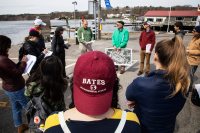
Econ 222 retires nine tons' worth of sulfur dioxide permits
In 2001, 2002 and 2003, at the rate of one permit per year, students in the “Environmental Economics” course at Bates bought and retired government permits for the atmospheric release of a pollutant that causes acid rain.
This year, in one fell swoop, the 49 students in Econ 222 quadrupled the amount of sulfur dioxide (SO2) that Bates is keeping out of the nation’s air. A $1,200 challenge grant from an environmental organization in Colorado spurred the students to submit winning bids for nine permits in the annual U.S. Environmental Protection Agency SO2-allowance auction.
Thanks to the Community Office for Resource Efficiency, in Aspen, and matching funds from supporters on campus, the students boosted Bates into the top ranks of colleges and universities successfully participating in the EPA auction. By retiring the SO2 permits, the 49 students will prevent the emission of an additional nine tons of this pollutant created by coal-burning power plants.
“This equals the amount of SO2 that would be emitted if you were to leave 3,600 100-watt light bulbs burning for one year straight,” says Lynne Lewis, associate professor of economics and the originator of the college’s annual bidding effort.
Under the 1990 Clean Air Act Amendments, coal-burning utilities are required to have emissions permits. These permits are tradable, and the emissions-allowance auction held each March by the Chicago Board of Trade disposes of some 250,000 allowances.
The Bates students bid $292 for each of the permits in this year’s auction, held March 22. The bid brought to 12 tons the amount of SO2 that the two sections of Lewis’ “Environmental Economics” have retired since 2001.
Since the auctions began, in 1993, dozens of educational institutions from grade school through graduate school have bought and retired permits. The University of Maryland School of Law and affiliated organizations have accumulated by far the most, at 75. Bates is in second place, with 12, and the University of Michigan Law School and affiliates third, with 9.
The challenge grant that quadrupled the students’ total appeared after CORE Executive Director Randy Udall read about Bates’ success in the auction process.
“He asked if our class could match his $1,200 and buy a total of eight permits, as well as educate others about the program,” Lewis explains. “My students designed informational fliers, sold T-shirts that they designed and had a booth in Commons,” the college’s dining hall.
Several campus organizations and many individuals at Bates contributed to the grant-matching drive. “We sold SO2 by the pound,” Lewis says. “Five pounds for a buck — you can’t beat that!” In the end, the students even came up with enough money to top Udall’s challenge by one permit.
Every year, Lewis’ students study past auctions and current markets, and then try to estimate what the price will be. She says, “I believe in learning by doing. We spend a lot of time learning about economic incentives for pollution control — what they are, how they work, when they are most effective, and so on. To tie this exercise in with what we’re learning in the classroom is a phenomenal experience.”
“It’s really exciting to be able to participate in an actual auction,” and the CORE challenge took the excitement to a new level, she says. “I’m really proud of my students. They worked hard on this and bid smart — and we are making a difference, too.”
Because of both its soil chemistry and its location downwind of the nation’s dirtiest utilities, Maine is particularly vulnerable to the effects of sulfur dioxide released by the burning of coal (mercury from the same source is another environmental threat).




